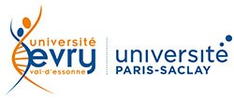

Genomic Tools
Provides general information about a genome.
The first block describes general information: Gram, NCBI tax ID and taxonomy, total number of CDS and length.
The second block presents the taxonomic classification according to GTDBtk.
The third block presents the completness and contamination as estimated by CheckM.
The following tables give some information about the replicons of the genome such as: Length, GC%, Ribosomal RNAs, tRNAs types, Annotations Status, Average CDS length, Repeated regions, Average intergenic length, Protein coding density, number of contigs/scaffolds etc.
The first block describes general information: Gram, NCBI tax ID and taxonomy, total number of CDS and length.
The second block presents the taxonomic classification according to GTDBtk.
The third block presents the completness and contamination as estimated by CheckM.
The following tables give some information about the replicons of the genome such as: Length, GC%, Ribosomal RNAs, tRNAs types, Annotations Status, Average CDS length, Repeated regions, Average intergenic length, Protein coding density, number of contigs/scaffolds etc.
CGView is a Circular Genome Viewing tool for visualizing and interacting with small genomes.
You can zoom in and out to see differents features of your genome, reorganise the order of the tracks ans toggle
the visibility of them and/or the different type of data displayed. Reference : CGView.js
This functionalty provides the list of Genomic regions containg tandem duplications of protein coding genes.
Tandem duplicated genes have an identity ≥ 35% with a minLRap ≥ 0.8 and are separated by a maximum of 5 consecutive genes.
This functionalty provides the number of CDS classified by eggNOG in at least one COG functional category.
eggNOG is a public database of orthology relationships, gene evolutionary histories and functional annotations. An Orthologous Group (OG) is defined as a cluster of three or more homologous sequences that diverge from the same speciation event. COG functional categories are updated for each OG.
eggNOG-mapper is used to transfer functional information from precomputed Orthologous Groups (OGs) from the EggNOG database to novel sequences.
Minimal Gene Set includes well conserved housekeeping genes for basic metabolism and macromolecular synthesis, many of which are essential genes
(the list of these genes is taken from Gil R, Silva FJ, Peretó J, «Moya A. Determination of the core of a minimal bacterial gene set.»
Microbiol Mol Biol Rev. 2004 Sep ;68(3):518-37).
To find the homologs, the tool analyses the similarity results between the genes of each organism and the set of 206 genes from 7 genomes (Escherichia coli K12, Bacillus subtilis 168, Candidatus Blochmania floridanus, Buchnera aphidicola APS, Buchnera aphidicola Bp, Buchnera aphidicola Sg and Mycoplasma genitalium G37).
The candidate genes have to fill one of the 2 following conditions :
To find the homologs, the tool analyses the similarity results between the genes of each organism and the set of 206 genes from 7 genomes (Escherichia coli K12, Bacillus subtilis 168, Candidatus Blochmania floridanus, Buchnera aphidicola APS, Buchnera aphidicola Bp, Buchnera aphidicola Sg and Mycoplasma genitalium G37).
The candidate genes have to fill one of the 2 following conditions :
- share a BBH relationship with a minLRap > 0.5
- belong to a synteny group

 Loading
Data ...
Loading
Data ...







